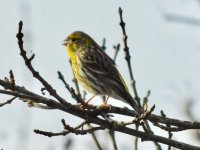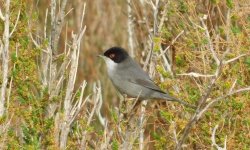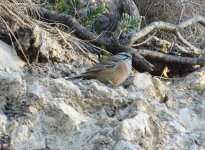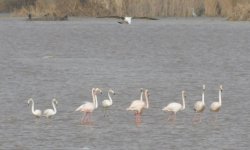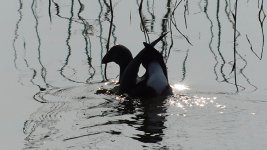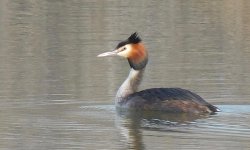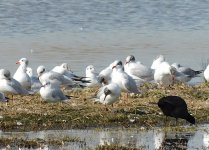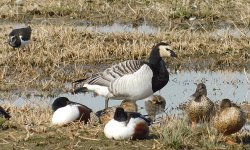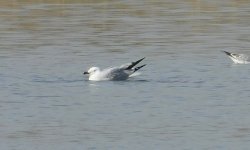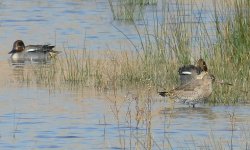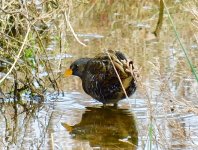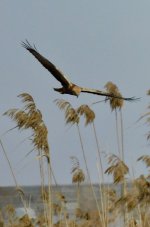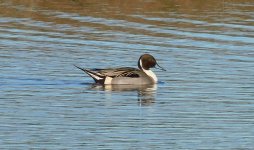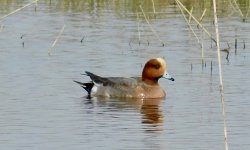...the best of the wintering and resident species, one or two vagrants and my first Spring migrant. Bonelli's Eagle, Iberian Grey Shrike, Iberian Woodpecker, Moustached Warbler, Stone-curlew, Rock Sparrow, Yelkouan Shearwater and Spotted Crake are just some of the 100+ species I recorded - en route to picking my son up to take him to footy. 
The Garraf Massis and the Llobregat Delta, Barcelona, 16.02.17
Already pitched up in situ, as first light came up on a mixed-habitat farmstead along the coastal GARRAF MASSIS, I watched and listened to Robin, Crested Tit, Wren and Firecrest all busying themselves in their respective micro-layers of the Aleppo Pine forest that bordered the vineyard.
Before long, the Long-tailed Tits I could hear made their way to join us bringing their trailing guest, a single, melodic-whistling Short-toed Treecreeper with them.
As a Blackbird cackled past me in one direction, I spun back in the other, to the sudden singing of a Cirl Bunting and for once I caught it with ease, perched on the summit of a leafless tree, mouth opened to the skies and trilling. A small flock of Serin started the morning's gossip excitedly in the branches above me and two or three Crested Lark joined in from an adjacent fallow field.
Yes, there’s a lot of song about today I contemplated. It was a calm, warm morning and this felt like the last day of Winter.
A Kestrel and a Sparrowhawk simultaneously and fortuitously arrowed across and dissected the whole landscape, putting up many wintering Common Starlings, amongst them a few resident Spotless Starlings and a dozen or so Rock Sparrow (aka Rock Petronia) onto the overhead cables. This latter species spend a lot of time on overhead cables but I did expect more of the up-to-200 that overwinter in the area.
Nevertheless, with no sign of Woodlark among others, I made my journey back to the car serenaded and/or chaperoned in turn by Chaffinch, Mistle Thrush, Sardinian Warbler, Greenfinch, Goldfinch, Wood Pigeon, Song Thrush and Jay.
By the way, I’ve deliberately neglected to use the superfluous “European” and “Eurasian” prefixes that have been inflicted upon our ages-old bird names in recent times as the repetition is not easy on the eye in a written trip report and..oh, yes, no one uses them anyway.
And, if you’re wondering, in case it helps anyone visiting, I’ve under-lined species that are scarce, difficult or quite local in their distribution throughout the area covered by today’s trip.
Before I even exited the car at my next port of call on the cliffs of the Costa Dorada, I added White Wagtail, Black Redstart and Yellow-legged Gull.
As I started my walk a Blue Rock Thrush was already singing too, surrounded by a hundred or so circling Crag Martin warming up for the day, but my first precursory scan of the sea revealed only a single adult Northern Gannet.
However, after tracking three Rock Bunting, first alerted to by the almost inaudible call, a feint, high-pitched “seet” that gives the bird its name in Catalan, a more serious attempt proved more fruitful, although credit for the small group of Yelkouan Shearwater should probably go to the pilot of the fishing boat that was making its way south.
My attempts and failure to separate Balearic Shearwater from a much larger, much further-out flock of shearwaters were watched by an cocky Peregrine perched up on the cliff above me. His eyes could split them I’m sure and I knew they were certainly mixed in but count them I couldn’t and, after quickly checking in the undergrowth to pick up Dunnock, I left him to continue to feast his eyes upon the wary Rock Doves.
The Collins Bird Guide, I notice, claims that Rock Doves are now ‘confined to Mediterranean area and coastal cliffs of Western Europe’. I’m not convinced. But I’ll take it.
A retrospective tot-up puts this at 34 species. Next stop, LLOBREGAT DELTA.
(photos: Serin, Sardinian Warbler, Rock Bunting, Red-legged Partridge, Greater Flamingo).
.
The Garraf Massis and the Llobregat Delta, Barcelona, 16.02.17
Already pitched up in situ, as first light came up on a mixed-habitat farmstead along the coastal GARRAF MASSIS, I watched and listened to Robin, Crested Tit, Wren and Firecrest all busying themselves in their respective micro-layers of the Aleppo Pine forest that bordered the vineyard.
Before long, the Long-tailed Tits I could hear made their way to join us bringing their trailing guest, a single, melodic-whistling Short-toed Treecreeper with them.
As a Blackbird cackled past me in one direction, I spun back in the other, to the sudden singing of a Cirl Bunting and for once I caught it with ease, perched on the summit of a leafless tree, mouth opened to the skies and trilling. A small flock of Serin started the morning's gossip excitedly in the branches above me and two or three Crested Lark joined in from an adjacent fallow field.
Yes, there’s a lot of song about today I contemplated. It was a calm, warm morning and this felt like the last day of Winter.
A Kestrel and a Sparrowhawk simultaneously and fortuitously arrowed across and dissected the whole landscape, putting up many wintering Common Starlings, amongst them a few resident Spotless Starlings and a dozen or so Rock Sparrow (aka Rock Petronia) onto the overhead cables. This latter species spend a lot of time on overhead cables but I did expect more of the up-to-200 that overwinter in the area.
Nevertheless, with no sign of Woodlark among others, I made my journey back to the car serenaded and/or chaperoned in turn by Chaffinch, Mistle Thrush, Sardinian Warbler, Greenfinch, Goldfinch, Wood Pigeon, Song Thrush and Jay.
By the way, I’ve deliberately neglected to use the superfluous “European” and “Eurasian” prefixes that have been inflicted upon our ages-old bird names in recent times as the repetition is not easy on the eye in a written trip report and..oh, yes, no one uses them anyway.
And, if you’re wondering, in case it helps anyone visiting, I’ve under-lined species that are scarce, difficult or quite local in their distribution throughout the area covered by today’s trip.
Before I even exited the car at my next port of call on the cliffs of the Costa Dorada, I added White Wagtail, Black Redstart and Yellow-legged Gull.
As I started my walk a Blue Rock Thrush was already singing too, surrounded by a hundred or so circling Crag Martin warming up for the day, but my first precursory scan of the sea revealed only a single adult Northern Gannet.
However, after tracking three Rock Bunting, first alerted to by the almost inaudible call, a feint, high-pitched “seet” that gives the bird its name in Catalan, a more serious attempt proved more fruitful, although credit for the small group of Yelkouan Shearwater should probably go to the pilot of the fishing boat that was making its way south.
My attempts and failure to separate Balearic Shearwater from a much larger, much further-out flock of shearwaters were watched by an cocky Peregrine perched up on the cliff above me. His eyes could split them I’m sure and I knew they were certainly mixed in but count them I couldn’t and, after quickly checking in the undergrowth to pick up Dunnock, I left him to continue to feast his eyes upon the wary Rock Doves.
The Collins Bird Guide, I notice, claims that Rock Doves are now ‘confined to Mediterranean area and coastal cliffs of Western Europe’. I’m not convinced. But I’ll take it.
A retrospective tot-up puts this at 34 species. Next stop, LLOBREGAT DELTA.
(photos: Serin, Sardinian Warbler, Rock Bunting, Red-legged Partridge, Greater Flamingo).
.
Attachments
Last edited:




